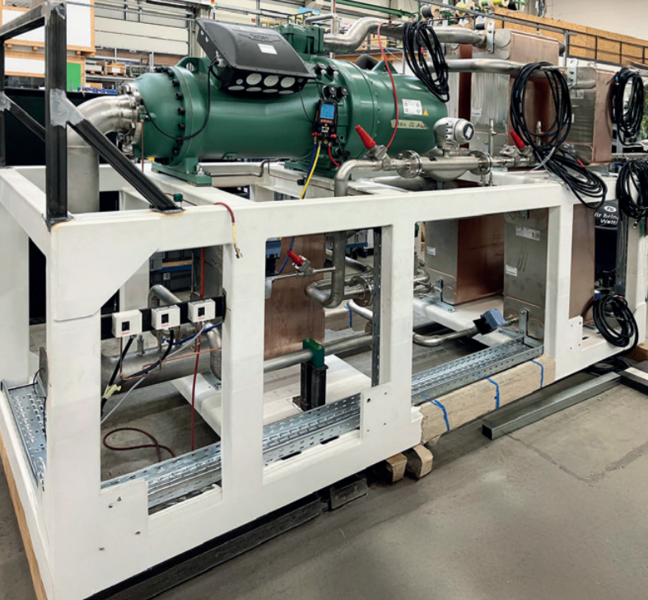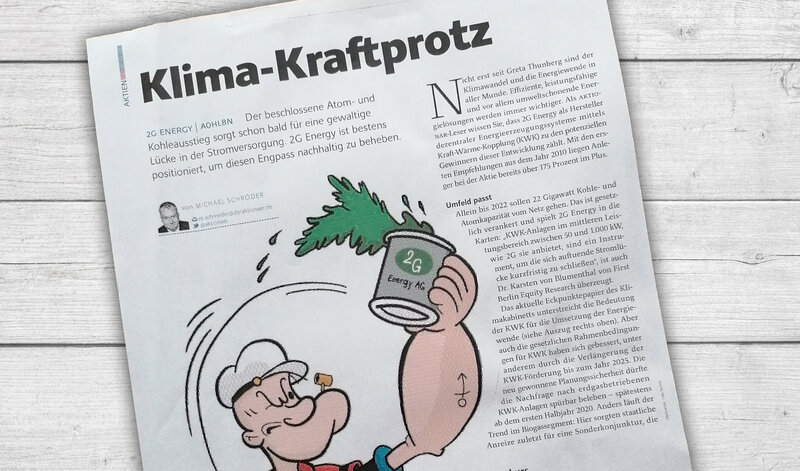Temperature options for large heat pumps
November 17, 2025

Large heat pumps play a key role in the decarbonization of heat supply. The widespread implementation of this technology requires targeted investment, grid optimization, and planning security. But what are the limits in terms of possible flow temperatures? The following section shows the influence of different flow temperatures on the selection, size, operation and investment costs of heat pumps.
Large heat pumps are increasingly being used for heat supply in district heating networks, local heating networks, neighborhoods, and special buildings such as hospitals. Required flow temperatures vary depending on the application. From a purely technical point of view, the technology available today enables that all heating networks can be served by heat pumps; however, this must always be checked from a commercial point of view. Heat networks are divided into different generations.
Different types of heat network generations
Third-generation heat networks use pressurized hot water with flow temperatures typically around 90–110 °C. At these high temperatures, heat losses in the distribution network are relatively large. This becomes particularly noticeable in summer, when heat demand is low and a greater proportion of the generated heat is lost through the network.
Fourth-generation heat networks operate with reduced flow temperatures — typically around 70 °C — which significantly lowers distribution heat losses. In summer, when heat demand is minimal, the proportion of heat lost in the network becomes especially noticeable. The lower temperature level enables the efficient integration of renewable and low-grade heat sources, including solar thermal energy, geothermal energy, industrial waste heat, and large heat pumps.
Fifth-generation heating networks — also known as cold local heating networks or anergy networks — are particularly effective when combined with heat pumps. These networks enable both heating and cooling to be provided through a single infrastructure. Waste heat from buildings with cooling demand can be transferred to buildings requiring heating, allowing heating and cooling needs within the neighborhood to partially balance each other.
Local heating networks are smaller, local networks that are fed by on-site heating enters. District heating networks are often large networks with a high number of connected consumers, which are frequently fed by waste heat from large power plants and/or large heat pumps.
Operators of existing district heating networks, which cover around 15% of Germany's heating requirements and around 8% of its energy requirements, are faced with the challenge of replacing fossil fuels with climate-friendly energies. This opportunity is offered by large heat pump systems with a capacity range of 1 to 100 MW, primarily for tapping into renewable energy sources areas, for example from heat sources such as geothermal energy, water bodies, or waste heat.
In Germany in 2023, there were around 475 district heating and cooling network operators, 626 district heating producers, 54 heat storage operators, and 590 district heating suppliers. Market participation was significantly higher among local heating and district network operators, with just under 3,800 entities active in this segment. Large district heating networks are typically operated at high temperature levels. According to Agora Energiewende, these figures remained largely unchanged in 2024.
In summary, it can be said that:
• District heating: Traditional networks often require up to 110 °C, while modern concepts often operate at 65 to 85 °C.
• Local heating/ districts: Here, 40 to 70 °C is standard on the market, while highly efficient systems aim for 40 to 50 °C, as this has a positive effect on the efficiency of the heat pump.
• Hospitals/retirement homes: 70 to 90 °C due to central drinking water storage tanks, hygiene requirements and medical technology.
The temperature level requirement has a decisive influence on the choice of heat pump technology and the refrigerant used.
Refrigerant options
The choice of refrigerant limits the technically achievable flow temperature (Figure 1). Due to the requirements of Regulation (EU) 2024/573, hydrocarbons or natural refrigerants are being used more and more frequently.
Ammonia (R717)
Ammonia has both a global warming potential (GWP) and an ozone depletion potential (ODP) of zero, making it future-proof in terms of legal prohibitions. Compared to synthetic alternatives, it is significantly cheaper and requires significantly lower quantities of refrigerant per installed heating capacity.
Typically, only about 60 to 70 kg of ammonia are required for 1 MW of heating capacity, whereas modern HFO refrigerants require up to 500 kg. In addition to its sustainability, ammonia has been established in industry for more than 100 years, is readily available, and is easily identifiable by its smell in the event of leaks. On the other hand, there are challenges in dealing with its toxicity, which is why comprehensive safety requirements according to DIN EN 378 and TRAS 110 must be strictly adhered to.
Propane (R290)
Established for monoblock heat pumps in the building sector, propane is suitable for flow temperatures of up to around 70 to 75 °C. It is popular due to its low GWP and good energy properties.
CO2 (R744)
Today, maximum flow temperatures of up to 90 °C can be achieved as standard. In order to operate truly efficiently, CO2 requires the highest possible spread between flow and return temperatures – around 90 to 40 °C. Efficiency is often below average with a small spread, which is why it is particularly suitable for hot water or process heat applications with a large temperature lift.
HFO/ HFC
HFO/HFC (e.g., R1234ze(E), R513A) are used as replacements for traditional HFCs (such as the now obsolete R134a) and enable temperatures of up to approximately 80 to 85 °C. However, their importance is declining in light of the stricter F-Gas Regulation.
Influence of heat source temperature
The heat source temperature defines the efficiency and the possible flow temperature. The higher the source temperature, the easier and more efficient it is to raise the flow temperature. For larger temperature lifts (> 50 K), two-stage compression is generally used. CO2 is an exception, as the transcritical process also allows for large temperature differences with acceptable efficiencies when the spread is high.
COP estimation/ Carnot COP and compressor selection
The theoretically achievable Carnot COP is calculated as follows (temperatures in Kelvin):
COP Carnot = Tsink /(Tsink - Tsource)
This Carnot COP is multiplied by the Carnot efficiency, which in practice is between 45 and 65%, to obtain the actual COP. For estimation purposes, there are diagrams that show the COP dependent of the temperature lift and the coefficient of performance (Figure 2).
Depending on the coefficient of performance and temperature lift, practical COPs range between 2 and 4 at flow temperatures of 70 to 85 °C and source temperatures of 6 to 14 °C – with ammonia regularly at the upper end. As the temperature lift increases, the COP decreases.
The draft of VDI 4646 “Application of large heat pumps” also enables an estimation of the COP depending on the temperature lift to be achieved using various diagrams. Here, a curve for synthetic refrigerants (HFC, HFO) and for an R717 ammonia heat pump is displayed (Figure 3).
Compressor selection dependent on temperature lift
The greater the required temperature lift, the more selective the compressor type must be. When comparing compressor technologies, it becomes clear that reciprocating compressors and screw compressors have different strengths. Reciprocating compressors are generally characterized by high efficiency, especially at partial load, and are suitable for smaller capacities in the range up to 5 MW.
They can be operated very flexibly and are therefore ideal when frequent load fluctuations occur during operation. However, they require more maintenance, have more moving parts, and tend to cause higher noise emissions. Screw compressors, on the other hand, require less maintenance, run with low vibration and noise and, through the use of oil injection during compression, can enable temperature strokes of up to 95 °C. This makes them the right choice, especially for large capacities above 5 MW. The required installation space is reduced compared to the use of reciprocating compressors.
Effects of flow temperature
The flow temperature affects investment and performance. Investment costs increase with increasing required flow temperature, as more powerful compressors, larger heat exchangers and, if necessary, high-pressure-resistant components are required. The heating output decreases at a constant source temperature with increasing temperature lift (see COP); at the same time, more electrical power is required to provide the same heat output.
Selecting “optimized” flow temperatures (e.g., 65 to 75 °C) instead of particularly high temperature levels can make a significant difference in the annual performance factor, payback period, and system flexibility. Ammonia heat pumps in particular offer an optimum balance of investment, operational reliability, and efficiency at 70 to 90 °C.
Heat pump design with different flow temperatures
The example of an isobutane R600a water-water heat pump (Figure 4) illustrates the influence of different source and sink temperatures on efficiency (COP) and potential heating capacity. Figure 5 shows a constant heat source inlet temperature of 20 °C, while Figure 6 shows a constant heat source inlet temperature of 45 °C. Both heat pumps operate with a spread of 5 K.
If a higher heat source temperature of 45 °C can be provided, a different lower temperature has a significantly greater effect on the possible heating output. At 60 °C / 35 °C, this is 1,140 kW, at 100 °C / 75 °C it is still 1,050 kW. Under these conditions, a COP of 7.5 or 3.9 can be achieved.
The data in Figures 5 and 6 are under full load conditions. In the partial load range, i.e., with reduced heating capacity and speed, the heat pump can achieve even higher efficiency with this compressor configuration with speed control via frequency converters. This applies to a range of approximately 50 to 80%. Since heat pumps
and refrigeration machines very often operate in the partial load range, the use of frequency converters is strongly recommended. This is particularly true when air is used as a heat source, which is available at very different temperatures throughout the year.
Conclusion
Large heat pumps offer enormous decarbonization potential for the transformation of heating networks with customized temperature options. Ammonia systems represent the energy and technical benchmark in the segment above 500 kW, while propane, butane, isobutane, and CO2 are also used in the lower power range.
Hydrocarbons are particularly suitable for temperatures > 90 °C. Highly efficient, future-proof grid integration can only be achieved with carefully coordinated source and grid temperatures, an optimal refrigerant system, and adequate compressor technology.
Source: EURO HEAT & POWER, Lars Keller, freier Autor TGA, Poing



















